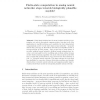Free Online Productivity Tools
i2Speak
i2Symbol
i2OCR
iTex2Img
iWeb2Print
iWeb2Shot
i2Type
iPdf2Split
iPdf2Merge
i2Bopomofo
i2Arabic
i2Style
i2Image
i2PDF
iLatex2Rtf
Sci2ools
142
click to vote
NEUROSCIENCE
2001
Springer
2001
Springer
Finite-State Computation in Analog Neural Networks: Steps towards Biologically Plausible Models?
Abstract. Finite-state machines are the most pervasive models of computation, not only in theoretical computer science, but also in all of its applications to real-life problems, and constitute the best characterized computational model. On the other hand, neural networks —proposed almost sixty years ago by McCulloch and Pitts as a simplified model of nervous activity in living beings— have evolved into a great variety of so-called artificial neural networks. Artificial neural networks have become a very successful tool for modelling and problem solving because of their built-in learning capability, but most of the progress in this field has occurred with models that are very removed from the behaviour of real, i.e., biological neural networks. This paper surveys the work that has established a connection between finite-state machines and (mainly discrete-time recurrent) neural networks, and suggests possible ways to construct finite-state models in biologically plausible neu...
Applied Computing | Artificial Neural Networks | Biological Neural Networks | Neural Networks | NEUROSCIENCE 2001 |
Related Content
| Added | 30 Jul 2010 |
| Updated | 30 Jul 2010 |
| Type | Conference |
| Year | 2001 |
| Where | NEUROSCIENCE |
| Authors | Mikel L. Forcada, Rafael C. Carrasco |
Comments (0)

